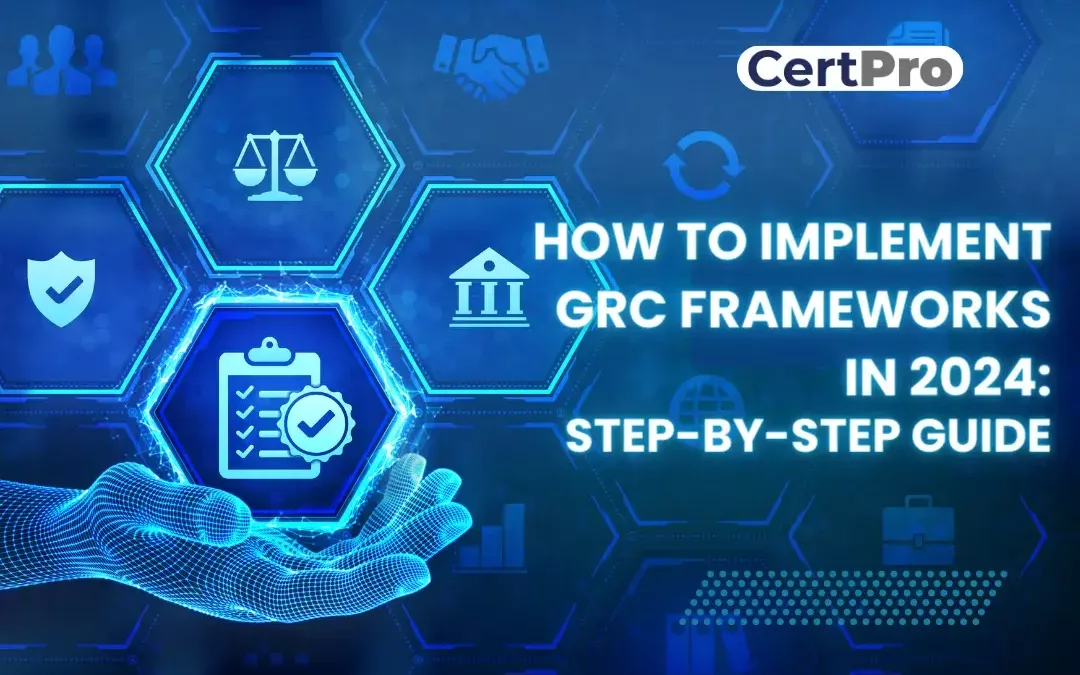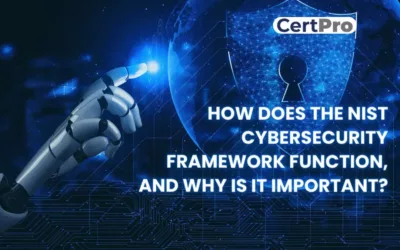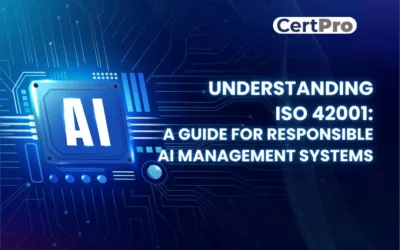The rapidly evolving business environment, complexity, and accountability enhance the importance of the organization’s governance, risk management, and compliance initiatives. Therefore, if your company finds difficulties expanding, recheck your organization’s regulatory requirements, ethical concerns, and cyber security threats. Thus, the organization must require a robust governance, risk, and compliance framework to navigate the assessment. At the same time, creating an effective GRC framework can be challenging and complicated.
This article will discuss step-by-step guidelines for implementing a practical GRC framework. The guidance will help you tailor a framework that aligns with your business goals and plans.
THE GRC FRAMEWORK
A GRC framework is an organization’s structural approach to managing its governance, risk assessment, and compliance efforts. It is considered a roadmap that enables systematic approaches to addressing operations processes. In addition, the GRC implementation helps your firm streamline operational processes and improve decision-making criteria. The framework’s application can effectively recognize potential risks and maintain regulatory compliance. Furthermore, the GRC framework promotes transparency, trust, and improved reputation.
Components of the GRC framework
The framework has three essential components. Each of them has its nature and importance in the framework.
Governance: Governance is a simple term for creating your firm’s rules, policies, and procedures. Therefore, it helps the firm plan its activities and align them with the business goal and strategy. Furthermore, governance includes managing ethical practices, accountability, and stability. It helps the top management control the organization. The process makes the operation more precise and goal-oriented. Thus, the component empowers employees as management controls their behaviors and resources. Therefore, governance defines the employees’ role and evaluates their efforts based on their performance. In this context, governance aims to create coordination among the stakeholders and provide them with control over the available facilities and infrastructure.
Risk Management: Risk management helps recognize and evaluate potential risks, which can be legal, strategic, or security-related. In addition, risk management effectively monitors controls and reduces the incidence of risks. The main aim is to achieve the objectives of identifying and mitigating risks related to cyber security. Therefore, it secures the firm’s core values.
Compliance: Compliance management considers your firm’s rules, policies, and procedures. It ensures that the organization adheres to industry-specific regulations. Therefore, non-compliance causes fines, penalties, and legal burdens. Regulatory compliance encompasses external laws and regulations related to industry and jurisdictions. In contrast, internal compliance deals with internal rules and regulations. Therefore, an effective compliance program enables the recognition of the risk areas and allocates more resources to mitigate the risk. In addition, it helps develop and implement policies to reduce risk. Lastly, an effective compliance process guides the employees and vendors regarding the best practices.
BUILD A GRC FRAMEWORK FOR YOUR BUSINESS
The below-stated steps help you create a GRC framework for your firm:
Consider the Objectives: A robust GRC framework must align with your organization’s commitment to your clients. Therefore, it is essential to understand your firm’s long—and short-term plans. The framework should be tailored to support your strategic vision. Furthermore, your organization’s key focus areas need consideration, and potential risks must be assessed.
Specify Governance Structure: Robust governance defines roles, responsibilities, and decision-making abilities. In addition, it describes the roles and responsibilities of board members, executives, and compliance offices within the framework. Therefore, developing communication channels and reporting processes ensures the effective flow of information within the organization. In addition, coordinating with the stakeholders regarding the perspective on risk and compliance is essential. Therefore, collaboration and communication foster a sense of ownership and accountability within your firm.
Recognize and Evaluate Risks: Identify and recognize your organization’s risks. This process involves risk analysis of business procedures and engages the stakeholders. Furthermore, analyzing policies and identifying potential risks can help the organization take the necessary steps to adhere to compliance. It enables the organization to prioritize potential risks and allocate proper resources to mitigate them.
Implement Controls and Processes: After identifying and assessing the risks, you can implement controls to manage the risks effectively. The process comprises policies, procedures, and practices that improve monitoring. In this regard, you can execute effective training programs for your employees regarding the information security framework. It enables their attentiveness to the process and reduces the risk of human error. Therefore, implementing an incidental response plan guides the employees’ actions in a crisis. In addition, the active controls ensure compliance with industry-specific regulations and standards.
Continuous Monitoring and Improvements: The GRC framework requires continuous monitoring and maintenance. It is not a one-time task. Therefore, the framework needs continuous improvement to ensure the organization’s security. Hence, if you are applying a GRC framework for your firm, regularly review the framework’s performance and address the areas needing improvement. In addition, you should consider the feedback from the stakeholders, conduct periodic assessments, and stay informed about industry-related best practices.
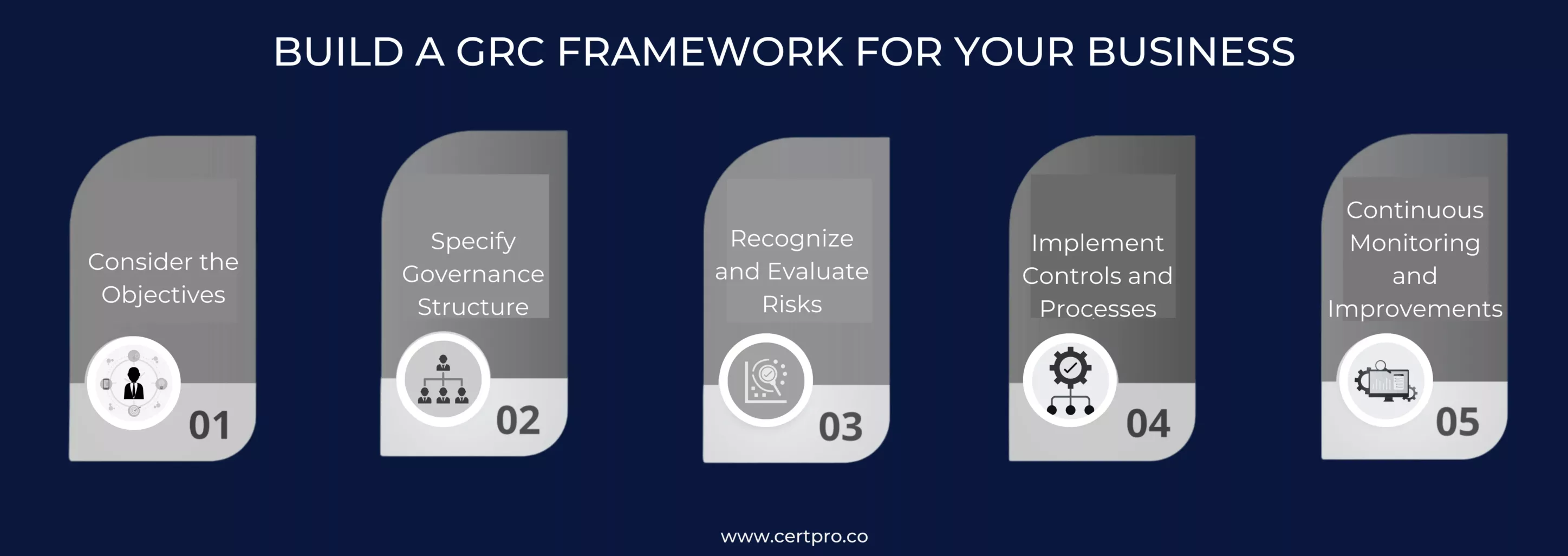
CHALLENGES OF GRC IMPLEMENTATION
Organizations can face challenges while integrating the GRC framework.
Change Management: GRC reports guide management in decision-making, which helps in business improvements. However, the organization must implement a change management program to act wisely based on the GRC reports.
Data Management: Organizations must have different departments with their respective functions. Therefore, each department generates and stores its own data. Thus, the GRC framework combines all the data from the organizations and analyzes it. However, this process can create duplicate data and create difficulties in managing the data.
Lack of GRC Framework: A complete GRC framework is required for the better functioning of the organization. It helps change the business environment and implement new regulations. However, a seamless integration of GRC can be fragmented and ineffective.
Transparency in Communication: The GRC framework enables transparency and clear communication among stakeholders and employees. It is necessary for creating and planning future policies and objectives. However, fragmentation in the GRC implementation can interfere with the process and prevent possibilities.
IMPLEMENT AN EFFECTIVE GRC STRATEGY IN YOUR ORGANIZATION
Implementing an effective GRC framework requires a proper understanding of the organization and its functionality. Therefore, the following steps can help you implement a robust GRC strategy for your organization.
Determine the Goals: The GRC implementation requires a defined goal at the initial stage. This suggests that your framework will work toward accomplishing the selected goal. For example, if you want to address the risk of non-compliance in your organization, your GRC should work that way.
Evaluate Existing Procedures: You must evaluate your organization’s current processes and technologies. In addition, you must be aware of your firm’s objectives and industry-specific rules and regulations. This helps you select the right GRC framework and tools for your organization.
Incorporate Senior Executives: Senior executives are essential in a GRC framework. Therefore, they should understand its benefits for the organization. They must be informed that it helps the decision-making process and manages risks. Their acceptance might help implement the framework effectively.
Use of GRC Solutions: GRC solutions can manage and monitor the GRC program. Therefore, they expose you to underlying processes, resources, and records. You can utilize tools to monitor regulatory compliance requirements.
Test Framework: Testing the GRC framework helps the organization understand its effectiveness in achieving the business goal. Small-scale testing can help you create an appropriate GRC system for your organization.
Specify Responsibilities: It is a team effort. In this process, senior executives are responsible for making the policies, considering the legal, financial, and technological aspects. In the framework, each employee must have specific responsibilities and accountabilities. The process allows employees to report issues in GRC.
BENEFITS OF THE GRC FRAMEWORK
Execution of the GRC framework makes the operational process easier. The other benefits are listed below:
Improve Operational Efficiency: The frameworks help automate standard processes. In this regard, continuous monitoring of controls and risk assessment automates the whole process. It reduces manual efforts in the documentation process, emails, and direct interactions. Thus, the framework eliminates redundant work, slow processing, and more. Hence, it improves your organization’s operations process.
Improve Decision-Making Process: Implementing the framework brings an integrated approach and a close monitoring process. Therefore, the management has complete ideas about the firm’s status. It shows a positive impact on the decision-making process.
Cost Reduction: The GRC framework defines your organization’s rules and controls. The reviewing process improves the effectiveness of the controls. Thus, the framework leads to the proper utilization of resources and reduces the cost of functioning and liabilities.
Transparency: Transparency is essential for businesses. Therefore, implementing the GRC framework makes your firm’s operational process visible. GRC helps you gain comprehensive visibility for involved parties and improves their understanding of the data, risks, and processes. The process allows the departments within the firm to work independently. Thus, it enhances the employees’ involvement and visibility within the organization.
Time-Saving: In a fast-moving world, assessing risks, managing compliance, and tracking internal audits can be time-consuming and complex. Therefore, the GRC framework centralizes the process by using a simple tool. The GRC implementation considers risk-related processes, internal audits, and compliance. Hence, it simplifies complex and time-consuming processes and increases operational efficiency.
Risk and security: Implementing the framework reduces the risks. The framework aids in managing, monitoring, and tracking the risks. Therefore, it helps management make wise decisions regarding market demands. In addition, it helps resource management reduce risks.
The GRC framework offers proactive risk assessment, a continuous monitoring process, and prioritizes compliance requirements. It also allows risk assessment and assesses the control’s efficacy. Therefore, the GRC framework provides a comprehensive compliance monitoring and improvement procedure solution. The process reduces risks, implements controls, rechecks the control’s effectiveness, and trains the employees. It is a great process that simplifies access management and maintains compliance standards.
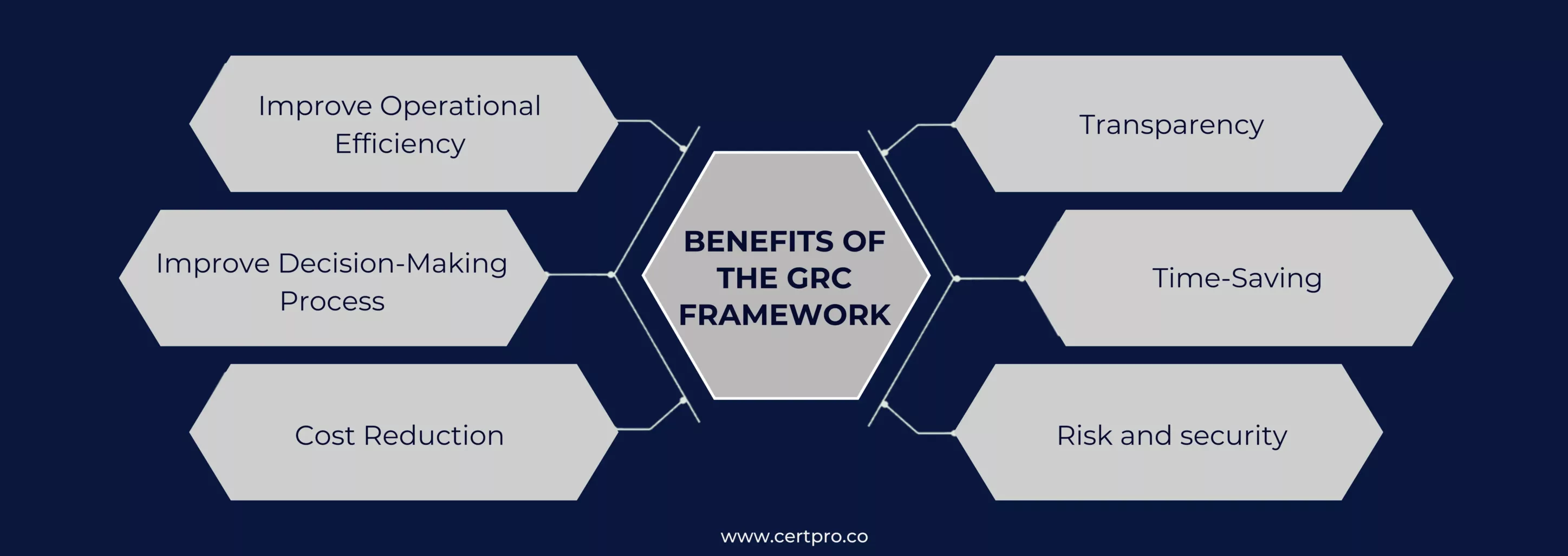
FAQ
Which industries require the GRC framework?
Industries related to healthcare, finance, pharmaceuticals, manufacturing, and engineering can implement a framework to improve their operational processes.
What is a GRC tool?
GRC tools are created to provide a unified approach to governance, risk, and compliance. It also provides a framework and a full suite of management capabilities.
What is the GRC roadmap?
GRC is an organizational strategy for managing industry-specific regulations. It identifies compliance requirements, policy management, risk assessment, and security control implementation.
Why is GRC becoming increasingly important?
Increasing compliance demands make the GRC more effective in maintaining regulations and standards. It decreases the risk of non-compliance penalties and reputational damage.
What are GRC Controls?
GRC controls refer to the policies, procedures, and activities implemented within an organization’s GRC framework. It manages risks effectively, maintains compliance with regulations, and achieves strategic goals.

About the Author
BHOOMIKA JOIS
Bhoomika Jois is a creative content writer specializing in compliance, ISO 27001, GDPR, and SOC 2. As a Social Media Marketing Specialist, she amplifies her engaging content. Bhoomika’s knack for simplifying complex topics makes compliance and cybersecurity accessible to all.
HOW DOES THE NIST CYBERSECURITY FRAMEWORK FUNCTION, AND WHY IS IT IMPORTANT?
Emerging cyber threats make cybersecurity an essential consideration for organizations handling and managing data. In this regard, the NIST cybersecurity framework applies to improving your cybersecurity program. It is a set of guidelines that helps improve your...
UNDERSTANDING ISO 42001: A GUIDE FOR RESPONSIBLE AI MANAGEMENT SYSTEMS
The invention of artificial intelligence (AI) has changed the operational processes of many industries. However, the rapid growth of technology increases ethical, security, and privacy-related concerns. Therefore, the International Organization for Standardization...
EUROPEAN UNION’S ARTIFICIAL INTELLIGENCE ACT: HOW THIS GROUNDBREAKING LAW AFFECTS YOUR BUSINESS
Nowadays, Artificial Intelligence (AI) is transforming our lives exceptionally well. AI is now streamlining healthcare services, providing virtual assistance, and fulfilling queries. Technologies have boons and curses. Similarly, AI creates many concerns about...

